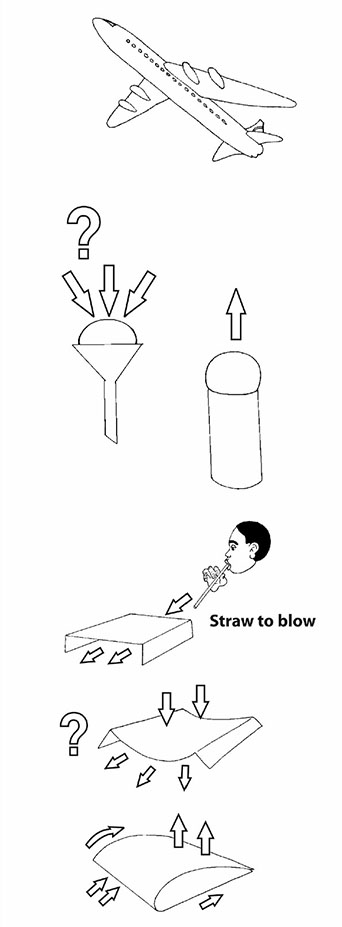Resource 3: ‘What lifts an airplane?’ Practical activities to carry out with your class
![]() Teacher resource for planning or adapting to use with pupils
Teacher resource for planning or adapting to use with pupils
The teacher at KamonkoliHigh Schoolmade Paulina photocopies of some notes from a primary science workshop that he had once attended.
These notes are copied for you below. Paulina worked through these activities with her class; they were fascinated and kept asking more questions.
One of the questions that children ask is ‘What keeps something heavy like an airplane up in the air?’ This is a really good question. Their teacher explained that there were a number of practical things that could be done to hint at how an airplane was lifted. But it does take quite careful explaining. One way to get people thinking is to compare blowing ping-pong balls with two different tools. You need the cardboard tube of a used toilet roll and a plastic funnel. You want to blow the ping-pong ball against the ceiling. Ask the class to predict which tool will be the best ping-pong ball blower – the toilet-roll tube or the plastic funnel. Then let them try. Now this is something to think about because the result is quite unexpected!!! What is happening in the funnel that holds the ball down so strongly? It can only be the air! Another teacher gives us another practical activity to try. Make a little bridge of paper by folding down two sides. Use a straw to flow air under the ‘bridge’. What do you predict will happen? What does happen? Why does the bridge collapse inwards and not bulge outwards? A third thing to try is to fold a sheet of A4 paper slightly off-centre, and then to glue down the two ends to form a model of the wing of a plane or a bird. Blow straight against the front edge and see what happens. The paper model lifts up. Why? |  | |
Clues Think of a group or cluster of people walking along a road. They hear something dangerous behind them and start to run away. What happens to the arrangement of people? Yes. They tend to spread out as their speed increases. Now, try the same thing with a handful of marbles. First roll them slowly across a smooth surface and they tend to stay clumped together. Then roll them more speedily and they tend to spread out. When air is forced to move more quickly over a curved surface or through a narrow space, the particles spread out. This means that there is less pressure. So you can get a strong force or lift from the air on the other side. It can be useful to observe and compare things dropping or falling through air. First we tried paper races. We compared the way two identical bits of paper, labelled A and B, fall through air. Why does a crumpled sheet fall more quickly? Trying to find the best words to describe the observed movement of the flat sheet and the crumpled ball makes for an excellent multilingual language activity. Paper A (flat) Floats Wobbles Twists Dives Zigzags, like a leaf or a feather Paper B (crumpled) Drops Straight Fast Falls, like a stone |  | |
Adapted from: Primary Science Programme Grade 4 Air Workshop Report
Resource 2: Air experiments



